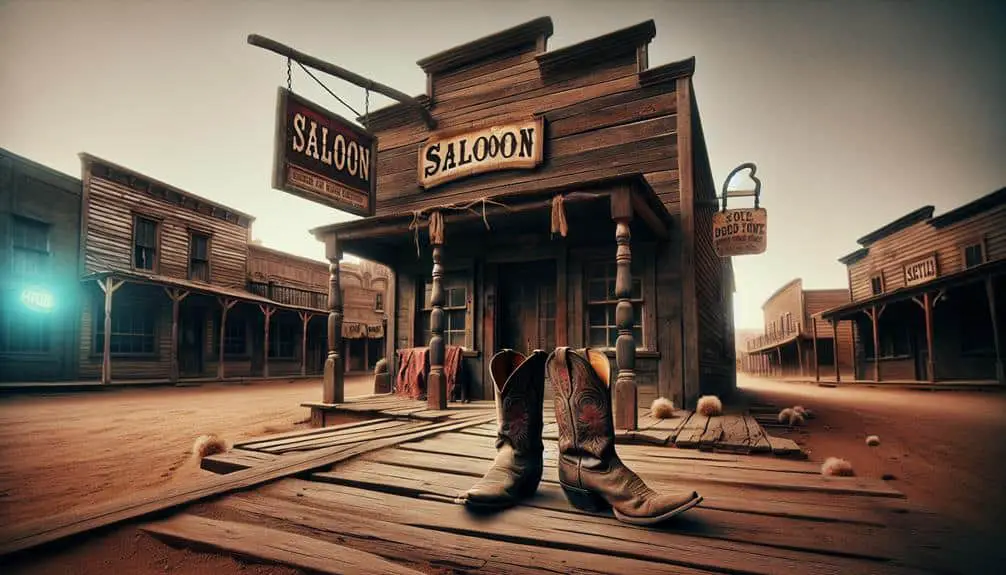Step into the remnants of forgotten Wild West villages in the United States. Witness the eerie ghost towns frozen in time, showcasing the rise and fall of economic fortunes. Explore once-thriving mining communities now deserted, reflecting the boom and bust cycles of the past. Discover famous abandoned landmarks that tell unique stories of past glory, attracting thrill-seekers with their haunted allure. Experience the reasons behind their desertion, from environmental disasters to economic collapse. These modern-day ghost towns stand as eerie reminders of a bygone era, preserved to maintain their historical significance. Uncover the mysteries of these lost settlements.
Key Points
- Wild West ghost towns linked to economic shifts and mining success.
- Boom and bust cycles due to resource depletion and market fluctuations.
- Abandoned landmarks reveal unique stories of past glory and allure.
- Desertion caused by environmental disasters, economic collapse, and isolation.
- Modern ghost towns result from economic decline, urban legends, and preservation efforts.
Origins of Ghost Towns
The birth of ghost towns can often be traced back to a combination of economic shifts and natural disasters. In the case of mining towns, the prosperity of these settlements was closely tied to the success of the mining operations. When the mines ran dry or when the market demand for specific minerals decreased, the economic foundation of these towns crumbled, leading to abandonment and ultimately ghost town status.
Railroad expansion played a significant role in the rise and fall of many ghost towns across the United States. Towns that were established as railroad stops or as a result of the economic opportunities brought by the railroads often faced an uncertain future when the tracks were rerouted or when the importance of these locations diminished over time.
Understanding the origins of ghost towns provides valuable insight into the dynamic relationship between economic forces, natural occurrences, and human settlement patterns. It serves as a reminder of the transient nature of communities and the enduring impact of external factors on local livelihoods.
Boom and Bust Cycles
During the boom and bust cycles of ghost towns in the United States, economic fluctuations and shifting industries often determined the fate of these once-thriving communities. Mining towns, in particular, were highly susceptible to rapid changes in their economic prosperity. Here are some key points to ponder:
- Resource Depletion: The rapid extraction of valuable resources led to economic booms but eventually resulted in resource depletion, causing economic decline.
- Technological Advances: Innovations in mining technology often made certain mining practices obsolete, leading to a decline in the town's economic viability.
- Market Fluctuations: Shifts in demand for specific minerals or metals could quickly turn a prosperous mining town into an economically struggling community.
- Labor Unrest: Strikes and labor disputes within mining towns could disrupt production, leading to economic downturns and population exodus.
- Environmental Impact: The environmental consequences of mining activities could eventually render a town uninhabitable, contributing to its abandonment due to economic and health concerns.
Understanding these factors sheds light on the delicate balance that mining towns faced during their boom and bust cycles.
Famous Abandoned Landmarks
Amidst the remnants of once-thriving communities lie famous abandoned landmarks, each telling a unique story of past glory and eventual abandonment. These sites often become haunted attractions, drawing thrill-seekers and history enthusiasts alike. Urban legends and tales of paranormal activity often swirl around these locations, adding to their mystique and allure.
Despite their desolate appearance, some of these landmarks are being targeted for preservation efforts. Organizations and individuals recognize the importance of these sites in preserving the history and culture of the regions they once thrived in. By maintaining these structures, they hope to keep the stories of the past alive for future generations to explore and learn from.
From abandoned mining towns to forgotten amusement parks, these landmarks stand as silent witnesses to a bygone era. Exploring these sites offers a glimpse into the past, allowing visitors to connect with history in a tangible way.
Reasons for Desertion
As you explore these abandoned landmarks, you can uncover a variety of reasons for their desertion, shedding light on the circumstances that led to their eventual abandonment. Ghost towns in the United States hold a mysterious allure, with each deserted settlement telling a unique story of its downfall. Here are some key reasons why these once-thriving communities were left deserted:
- Environmental Disasters: Natural calamities like droughts, floods, or wildfires often ravaged these towns, making them uninhabitable.
- Economic Collapse: The sudden decline of industries such as mining or logging, which were the lifeblood of these towns, led to economic collapse and mass exodus.
- Depletion of Resources: Exhaustion of key resources like gold or timber made it unsustainable for residents to continue living in these areas.
- Isolation and Accessibility: Some towns became isolated due to changing transportation routes, making it impractical for people to stay.
- Health Epidemics: Outbreaks of diseases like cholera or influenza could wipe out populations, leaving behind empty streets and buildings.
These factors combined to create the eerie ghost towns that stand frozen in time, waiting to tell their tales of prosperity turned to desolation.
Modern-Day Ghost Towns
Uncovering the remnants of once-bustling communities, the focus now shifts to exploring the phenomenon of modern-day ghost towns in the United States. Modern-day ghost towns are often a result of economic decline, leading to population loss and the abandonment of entire settlements. These areas, once vibrant with life and activity, now stand as eerie reminders of a bygone era.
Urban legends often surround these modern ghost towns, adding to their mystique and allure. Tales of lost fortunes, tragic events, or mysterious disappearances contribute to the fascination with these deserted places. Despite their desolate appearance, some modern ghost towns have sparked preservation efforts aimed at maintaining their historical significance.
As you investigate the stories behind these modern-day ghost towns, you may uncover the complex web of factors that contributed to their decline. From changing economic landscapes to natural disasters, each ghost town has a unique narrative waiting to be discovered. Through exploration and preservation, these forgotten communities continue to intrigue and captivate those seeking a glimpse into the past.
Frequently Asked Questions
Are There Any Ghost Towns in the United States That Have Been Completely Preserved as Historical Sites?
Yes, some ghost towns in the United States have been meticulously preserved for historical conservation, showcasing cultural heritage. These sites offer unique tourism opportunities, allowing visitors to step back in time and experience a glimpse of the past.
How Do Ghost Towns Impact the Surrounding Environment and Wildlife?
When exploring how ghost towns impact the environment, consider their role in ecosystem restoration. Abandoned areas may offer opportunities for wildlife conservation and habitat preservation. Understanding these effects is essential for balancing preservation and restoration efforts.
Are There Any Ghost Towns That Have Become Popular Tourist Destinations for Paranormal Activity?
If you're into paranormal tourism, you'll find ghost towns with haunted legends irresistible. These eerie places draw visitors seeking supernatural experiences. Ghost town attractions offer a peek into the past and a chance for spooky encounters.
What Efforts Are Being Made to Preserve and Protect the Remaining Structures in Ghost Towns From Further Decay?
Preservation efforts in ghost towns focus on restoring historic structures through restoration projects. Organizations and volunteers work tirelessly to protect these remnants of the past, ensuring they remain standing for future generations to appreciate.
Have There Been Any Instances of Ghost Towns Being Revitalized and Brought Back to Life as Thriving Communities?
Revitalization projects have successfully transformed some ghost towns into thriving communities. Through community growth initiatives and preservation efforts, these once-forgotten places have been revived, attracting new residents and visitors to experience their rich history.



